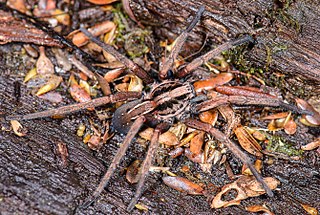
The Mygalomorphae, or mygalomorphs, are an infraorder of spiders, and comprise one of three major groups of living spiders with over 3000 species, found on all continents except Antarctica. Many members are known as trapdoor spiders due to their creation of trapdoors over their burrows. Other prominent groups include Australian funnel web spiders and tarantulas, with the latter accounting for around one third of all mygalomorphs.

The family Dipluridae, known as curtain-web spiders are a group of spiders in the infraorder Mygalomorphae, that have two pairs of booklungs, and chelicerae (fangs) that move up and down in a stabbing motion. A number of genera, including that of the Sydney funnel-web spider (Atrax), used to be classified in this family but have now been moved to Atracidae.

Atracidae is a family of mygalomorph spiders, commonly known as Australian funnel-web spiders or atracids. It has been included as a subfamily of the Hexathelidae, but is now recognized as a separate family. All members of the family are native to Australia. Atracidae consists of three genera: Atrax, Hadronyche, and Illawarra, comprising 35 species. Some members of the family produce venom that is dangerous to humans, and bites by spiders of six of the species have caused severe injuries to victims. The bites of the Sydney funnel-web spider and northern tree-dwelling funnel-web spider are potentially deadly, but no fatalities have occurred since the introduction of modern first-aid techniques and antivenom.

Nursery web spiders (Pisauridae) are a family of araneomorph spiders first described by Eugène Simon in 1890. Females of the family are known for building special nursery webs. When their eggs are about to hatch, a female spider builds a tent-like web, places her egg sac inside, and stands guard outside, hence the family's common name. Like wolf spiders, however, nursery web spiders are roaming hunters that don't use webs for catching prey.

Miturgidae is a family of araneomorph spiders that includes nearly 170 species in 29 genera worldwide. First described by Eugène Simon in 1886, it has been substantially revised, and includes the previous family Zoridae as a synonym, and excludes the family Xenoctenidae. Several genera have also been removed, such as the large genus Cheiracanthium, which was transferred to the Cheiracanthiidae.

Corinnidae is a family of araneomorph spiders, sometimes called corinnid sac spiders. The family, like other "clubionoid" families, has a confusing taxonomic history. Once it was a part of the large catch-all taxon Clubionidae, now very much smaller. The original members of the family are apparently similar only in that they have eight eyes arranged in two rows, conical anterior spinnerets that touch and are generally wandering predators that build silken retreats, or sacs, usually on plant terminals, between leaves, under bark or under rocks.

Hexathelidae is a family of mygalomorph spiders. It is one of a number of families and genera of spiders known as funnel-web spiders. In 2018, the family was substantially reduced in size by genera being moved to three separate families: Atracidae, Macrothelidae and Porrhothelidae. Atracidae includes the most venomous species formerly placed in Hexathelidae.

Microstigmatidae is a small family of spiders with about 25 described species in eight genera. They are small ground-dwelling and free-living spiders that make little use of silk.

Nemesiidae, also known as funnel-web trapdoor spiders, is a family of mygalomorph spiders first described by Eugène Simon in 1889, and raised to family status in 1985. Before becoming its own family, it was considered part of "Dipluridae".

Barychelidae, also known as brushed trapdoor spiders, is a spider family with about 300 species in 42 genera.

Aname atra, the black wishbone spider, is a mygalomorph spider of South Australia. It is one of the wishbone spiders in the taxonomic family Anamidae, found in varied habitats throughout Australia, including Tasmania. The most common species are the mottled eastern wishbones in the genus Namea, found in rainforests, black wishbones in the genus Aname, found in drier parts of Queensland, and the bearded wishbone, Xamiatus magnificus, also found in Queensland.
Masteria is a genus of curtain web spiders that was first described by L. Koch in 1873. They occur in the tropics of Central to South America, Asia and Micronesia, with one species found in Australia. M. petrunkevitchi males are 4 millimetres (0.16 in) long and females are 5 millimetres (0.20 in) long. M. lewisi, M. barona, and M. downeyi are slightly smaller and have only six eyes.

Stanwellia is a genus of South Pacific mygalomorph spiders in the family Pycnothelidae. It was first described by W. J. Rainbow & R. H. Pulleine in 1918. Originally placed with the curtain-web spiders, it was transferred to the funnel-web trapdoor spiders in 1985, then to the Pycnothelidae in 2020. It is a senior synonym of Aparua.
Caledothele is a genus of South Pacific spiders in the family Euagridae. It was first described by Robert Raven in 1991.
Xamiatus bulburin is a species of mygalomorph spider in the Microstigmatidae family. It is endemic to Australia. It was described in 1981 by Australian arachnologist Robert Raven.
Xamiatus rubrifrons, also known as the red-jawed bearded wishbone spider, is a species of mygalomorph spider in the Microstigmatidae family. It is endemic to Australia. It was described in 1981 by Australian arachnologist Robert Raven.
Xamiatus magnificus is a species of mygalomorph spider in the Microstigmatidae family. It is endemic to Australia. It was described in 1981 by Australian arachnologist Robert Raven.

Xamiatus kia is a species of mygalomorph spider in the Microstigmatidae family. It is endemic to Australia. It was described in 1981 by Australian arachnologist Robert Raven.
Xamiatus ilara is a species of mygalomorph spider in the Microstigmatidae family. It is endemic to Australia. It was described in 1982 by Australian arachnologist Robert Raven.













